[English] 日本語
 Yorodumi
Yorodumi- PDB-8imy: Cryo-EM structure of GPI-T (inactive mutant) with GPI and proULBP... -
+ Open data
Open data
- Basic information
Basic information
| Entry | Database: PDB / ID: 8imy | |||||||||||||||||||||||||||||||||||||||||||||||||||||||||||||||
|---|---|---|---|---|---|---|---|---|---|---|---|---|---|---|---|---|---|---|---|---|---|---|---|---|---|---|---|---|---|---|---|---|---|---|---|---|---|---|---|---|---|---|---|---|---|---|---|---|---|---|---|---|---|---|---|---|---|---|---|---|---|---|---|---|
| Title | Cryo-EM structure of GPI-T (inactive mutant) with GPI and proULBP2, a proprotein substrate | |||||||||||||||||||||||||||||||||||||||||||||||||||||||||||||||
 Components Components |
| |||||||||||||||||||||||||||||||||||||||||||||||||||||||||||||||
 Keywords Keywords | MEMBRANE PROTEIN / cryo-EM / glycosylphosphatidylinositol / GPI / GPI anchored protein / GPI-AP / membrane protein complex / proprotein | |||||||||||||||||||||||||||||||||||||||||||||||||||||||||||||||
| Function / homology |  Function and homology information Function and homology informationGPI-anchor transamidase activity / attachment of GPI anchor to protein / GPI-anchor transamidase complex / GPI anchored protein biosynthesis / GPI anchor biosynthetic process / GPI anchor binding / Attachment of GPI anchor to uPAR / protein retention in ER lumen / natural killer cell lectin-like receptor binding / Transferases; Transferring nitrogenous groups; Transaminases ...GPI-anchor transamidase activity / attachment of GPI anchor to protein / GPI-anchor transamidase complex / GPI anchored protein biosynthesis / GPI anchor biosynthetic process / GPI anchor binding / Attachment of GPI anchor to uPAR / protein retention in ER lumen / natural killer cell lectin-like receptor binding / Transferases; Transferring nitrogenous groups; Transaminases / Post-translational modification: synthesis of GPI-anchored proteins / natural killer cell activation / regulation of receptor signaling pathway via JAK-STAT / natural killer cell mediated cytotoxicity / antigen processing and presentation of endogenous peptide antigen via MHC class Ib / antigen processing and presentation of endogenous peptide antigen via MHC class I via ER pathway, TAP-independent / bioluminescence / generation of precursor metabolites and energy / positive regulation of T cell mediated cytotoxicity / neuron differentiation / neuron apoptotic process / cytoplasmic vesicle / immune response / receptor ligand activity / external side of plasma membrane / intracellular membrane-bounded organelle / centrosome / endoplasmic reticulum membrane / cell surface / endoplasmic reticulum / mitochondrion / proteolysis / extracellular space / extracellular region / membrane / plasma membrane / cytosol Similarity search - Function | |||||||||||||||||||||||||||||||||||||||||||||||||||||||||||||||
| Biological species |  Homo sapiens (human) Homo sapiens (human) Clavularia sp. (invertebrata) Clavularia sp. (invertebrata) | |||||||||||||||||||||||||||||||||||||||||||||||||||||||||||||||
| Method | ELECTRON MICROSCOPY / single particle reconstruction / cryo EM / Resolution: 3.22 Å | |||||||||||||||||||||||||||||||||||||||||||||||||||||||||||||||
 Authors Authors | Li, T. / Xu, Y. / Qu, Q. / Li, D. | |||||||||||||||||||||||||||||||||||||||||||||||||||||||||||||||
| Funding support |  China, 1items China, 1items
| |||||||||||||||||||||||||||||||||||||||||||||||||||||||||||||||
 Citation Citation |  Journal: Nat Commun / Year: 2023 Journal: Nat Commun / Year: 2023Title: Structures of liganded glycosylphosphatidylinositol transamidase illuminate GPI-AP biogenesis. Authors: Yidan Xu / Tingting Li / Zixuan Zhou / Jingjing Hong / Yulin Chao / Zhini Zhu / Ying Zhang / Qianhui Qu / Dianfan Li /  Abstract: Many eukaryotic receptors and enzymes rely on glycosylphosphatidylinositol (GPI) anchors for membrane localization and function. The transmembrane complex GPI-T recognizes diverse proproteins at a ...Many eukaryotic receptors and enzymes rely on glycosylphosphatidylinositol (GPI) anchors for membrane localization and function. The transmembrane complex GPI-T recognizes diverse proproteins at a signal peptide region that lacks consensus sequence and replaces it with GPI via a transamidation reaction. How GPI-T maintains broad specificity while preventing unintentional cleavage is unclear. Here, substrates- and products-bound human GPI-T structures identify subsite features that enable broad proprotein specificity, inform catalytic mechanism, and reveal a multilevel safeguard mechanism against its promiscuity. In the absence of proproteins, the catalytic site is invaded by a locally stabilized loop. Activation requires energetically unfavorable rearrangements that transform the autoinhibitory loop into crucial catalytic cleft elements. Enzyme-proprotein binding in the transmembrane and luminal domains respectively powers the conformational rearrangement and induces a competent cleft. GPI-T thus integrates various weak specificity regions to form strong selectivity and prevent accidental activation. These findings provide important mechanistic insights into GPI-anchored protein biogenesis. | |||||||||||||||||||||||||||||||||||||||||||||||||||||||||||||||
| History |
|
- Structure visualization
Structure visualization
| Structure viewer | Molecule:  Molmil Molmil Jmol/JSmol Jmol/JSmol |
|---|
- Downloads & links
Downloads & links
- Download
Download
| PDBx/mmCIF format |  8imy.cif.gz 8imy.cif.gz | 509.9 KB | Display |  PDBx/mmCIF format PDBx/mmCIF format |
|---|---|---|---|---|
| PDB format |  pdb8imy.ent.gz pdb8imy.ent.gz | 380.8 KB | Display |  PDB format PDB format |
| PDBx/mmJSON format |  8imy.json.gz 8imy.json.gz | Tree view |  PDBx/mmJSON format PDBx/mmJSON format | |
| Others |  Other downloads Other downloads |
-Validation report
| Summary document |  8imy_validation.pdf.gz 8imy_validation.pdf.gz | 2.2 MB | Display |  wwPDB validaton report wwPDB validaton report |
|---|---|---|---|---|
| Full document |  8imy_full_validation.pdf.gz 8imy_full_validation.pdf.gz | 2.3 MB | Display | |
| Data in XML |  8imy_validation.xml.gz 8imy_validation.xml.gz | 63.9 KB | Display | |
| Data in CIF |  8imy_validation.cif.gz 8imy_validation.cif.gz | 88.1 KB | Display | |
| Arichive directory |  https://data.pdbj.org/pub/pdb/validation_reports/im/8imy https://data.pdbj.org/pub/pdb/validation_reports/im/8imy ftp://data.pdbj.org/pub/pdb/validation_reports/im/8imy ftp://data.pdbj.org/pub/pdb/validation_reports/im/8imy | HTTPS FTP |
-Related structure data
| Related structure data |  35576MC  8imxC M: map data used to model this data C: citing same article ( |
|---|---|
| Similar structure data | Similarity search - Function & homology  F&H Search F&H Search |
- Links
Links
- Assembly
Assembly
| Deposited unit | 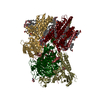
|
|---|---|
| 1 |
|
- Components
Components
-Protein , 4 types, 4 molecules GKUD
| #1: Protein | Mass: 96990.352 Da / Num. of mol.: 1 Source method: isolated from a genetically manipulated source Source: (gene. exp.)  Homo sapiens (human), (gene. exp.) Homo sapiens (human), (gene. exp.)  Clavularia sp. (invertebrata) Clavularia sp. (invertebrata)Gene: GPAA1, GAA1 / Production host:  Homo sapiens (human) / References: UniProt: O43292, UniProt: Q9U6Y3 Homo sapiens (human) / References: UniProt: O43292, UniProt: Q9U6Y3 |
|---|---|
| #2: Protein | Mass: 73426.992 Da / Num. of mol.: 1 Source method: isolated from a genetically manipulated source Source: (gene. exp.)  Homo sapiens (human), (gene. exp.) Homo sapiens (human), (gene. exp.)  Clavularia sp. (invertebrata) Clavularia sp. (invertebrata)Gene: PIGK, GPI8 / Production host:  Homo sapiens (human) / References: UniProt: Q92643, UniProt: Q9U6Y3, Hydrolases Homo sapiens (human) / References: UniProt: Q92643, UniProt: Q9U6Y3, Hydrolases |
| #3: Protein | Mass: 80691.539 Da / Num. of mol.: 1 Source method: isolated from a genetically manipulated source Source: (gene. exp.)  Homo sapiens (human), (gene. exp.) Homo sapiens (human), (gene. exp.)  Clavularia sp. (invertebrata) Clavularia sp. (invertebrata)Gene: PIGU, CDC91L1, PSEC0205, UNQ3055/PRO9875 / Production host:  Homo sapiens (human) / References: UniProt: Q9H490, UniProt: Q9U6Y3 Homo sapiens (human) / References: UniProt: Q9H490, UniProt: Q9U6Y3 |
| #6: Protein | Mass: 28790.344 Da / Num. of mol.: 1 Source method: isolated from a genetically manipulated source Source: (gene. exp.)  Homo sapiens (human) / Gene: ULBP2, N2DL2, RAET1H, UNQ463/PRO791 / Production host: Homo sapiens (human) / Gene: ULBP2, N2DL2, RAET1H, UNQ463/PRO791 / Production host:  Homo sapiens (human) / References: UniProt: Q9BZM5 Homo sapiens (human) / References: UniProt: Q9BZM5 |
-GPI transamidase component PIG- ... , 2 types, 2 molecules TS
| #4: Protein | Mass: 92825.766 Da / Num. of mol.: 1 Source method: isolated from a genetically manipulated source Source: (gene. exp.)  Homo sapiens (human), (gene. exp.) Homo sapiens (human), (gene. exp.)  Clavularia sp. (invertebrata) Clavularia sp. (invertebrata)Gene: PIGT, CGI-06, PSEC0163, UNQ716/PRO1379 / Production host:  Homo sapiens (human) / References: UniProt: Q969N2, UniProt: Q9U6Y3 Homo sapiens (human) / References: UniProt: Q969N2, UniProt: Q9U6Y3 |
|---|---|
| #5: Protein | Mass: 90421.062 Da / Num. of mol.: 1 Source method: isolated from a genetically manipulated source Source: (gene. exp.)  Homo sapiens (human), (gene. exp.) Homo sapiens (human), (gene. exp.)  Clavularia sp. (invertebrata) Clavularia sp. (invertebrata)Gene: PIGS, UNQ1873/PRO4316 / Production host:  Homo sapiens (human) / References: UniProt: Q96S52, UniProt: Q9U6Y3 Homo sapiens (human) / References: UniProt: Q96S52, UniProt: Q9U6Y3 |
-Sugars , 3 types, 4 molecules 


| #7: Polysaccharide | 2-acetamido-2-deoxy-beta-D-glucopyranose-(1-4)-2-acetamido-2-deoxy-beta-D-glucopyranose Source method: isolated from a genetically manipulated source | ||
|---|---|---|---|
| #16: Sugar | | #18: Sugar | ChemComp-PA1 / | |
-Non-polymers , 10 types, 34 molecules 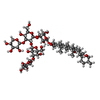
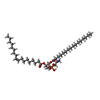


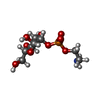


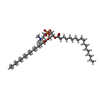
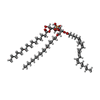
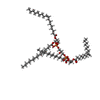









| #8: Chemical | ChemComp-AJP / | ||||||||||||||||
|---|---|---|---|---|---|---|---|---|---|---|---|---|---|---|---|---|---|
| #9: Chemical | ChemComp-6OU / [( #10: Chemical | ChemComp-Y01 / #11: Chemical | ChemComp-MG / | #12: Chemical | ChemComp-05E / | #13: Chemical | #14: Chemical | ChemComp-CA / | #15: Chemical | ChemComp-LBN / | #17: Chemical | ChemComp-81Q / [( | #19: Chemical | ChemComp-80T / [( | |
-Details
| Has ligand of interest | Y |
|---|---|
| Has protein modification | Y |
-Experimental details
-Experiment
| Experiment | Method: ELECTRON MICROSCOPY |
|---|---|
| EM experiment | Aggregation state: PARTICLE / 3D reconstruction method: single particle reconstruction |
- Sample preparation
Sample preparation
| Component | Name: Complex of GPI-T (inactive mutant) with GPI and proULBP2 Type: COMPLEX / Entity ID: #1-#6 / Source: MULTIPLE SOURCES | ||||||||||||||||||||
|---|---|---|---|---|---|---|---|---|---|---|---|---|---|---|---|---|---|---|---|---|---|
| Molecular weight | Value: 463 kDa/nm / Experimental value: NO | ||||||||||||||||||||
| Source (natural) | Organism:  Homo sapiens (human) Homo sapiens (human) | ||||||||||||||||||||
| Source (recombinant) | Organism:  Homo sapiens (human) Homo sapiens (human) | ||||||||||||||||||||
| Buffer solution | pH: 8 Details: 0.1 % Digitonin, 150 mM NaCl, 20 mM Tris-HCl pH 8.0 | ||||||||||||||||||||
| Buffer component |
| ||||||||||||||||||||
| Specimen | Conc.: 25 mg/ml / Embedding applied: NO / Shadowing applied: NO / Staining applied: NO / Vitrification applied: YES | ||||||||||||||||||||
| Specimen support | Grid material: GOLD / Grid mesh size: 300 divisions/in. / Grid type: Quantifoil R1.2/1.3 | ||||||||||||||||||||
| Vitrification | Instrument: FEI VITROBOT MARK IV / Cryogen name: ETHANE / Humidity: 100 % / Chamber temperature: 277 K |
- Electron microscopy imaging
Electron microscopy imaging
| Experimental equipment |  Model: Titan Krios / Image courtesy: FEI Company |
|---|---|
| Microscopy | Model: FEI TITAN KRIOS |
| Electron gun | Electron source:  FIELD EMISSION GUN / Accelerating voltage: 300 kV / Illumination mode: FLOOD BEAM FIELD EMISSION GUN / Accelerating voltage: 300 kV / Illumination mode: FLOOD BEAM |
| Electron lens | Mode: BRIGHT FIELD / Nominal magnification: 105000 X / Calibrated magnification: 53648 X / Nominal defocus max: 2500 nm / Nominal defocus min: 1000 nm / Cs: 2.7 mm / C2 aperture diameter: 50 µm / Alignment procedure: COMA FREE |
| Specimen holder | Cryogen: NITROGEN / Specimen holder model: FEI TITAN KRIOS AUTOGRID HOLDER |
| Image recording | Average exposure time: 2 sec. / Electron dose: 52 e/Å2 / Film or detector model: GATAN K3 (6k x 4k) / Num. of grids imaged: 1 / Num. of real images: 4555 |
- Processing
Processing
| Software | Name: PHENIX / Version: 1.18.2_3874: / Classification: refinement | ||||||||||||||||||||||||||||||||
|---|---|---|---|---|---|---|---|---|---|---|---|---|---|---|---|---|---|---|---|---|---|---|---|---|---|---|---|---|---|---|---|---|---|
| EM software |
| ||||||||||||||||||||||||||||||||
| Image processing | Details: The images were high-pass filtered and normalized | ||||||||||||||||||||||||||||||||
| CTF correction | Type: PHASE FLIPPING AND AMPLITUDE CORRECTION | ||||||||||||||||||||||||||||||||
| Particle selection | Num. of particles selected: 2981565 | ||||||||||||||||||||||||||||||||
| Symmetry | Point symmetry: C1 (asymmetric) | ||||||||||||||||||||||||||||||||
| 3D reconstruction | Resolution: 3.22 Å / Resolution method: FSC 0.143 CUT-OFF / Num. of particles: 176889 / Algorithm: FOURIER SPACE / Symmetry type: POINT | ||||||||||||||||||||||||||||||||
| Refine LS restraints |
|
 Movie
Movie Controller
Controller







 PDBj
PDBj














